By Philip Lord, carsales.com.au
Hyundai had the market cornered with its first-generation Kona Electric. That is if you wanted a small, battery-powered SUV. But now, as the second-generation arrives in Australia, it faces more competition, both from within Hyundai’s own showrooms and against rival brands that have entered the EV landscape.
Countering that, the new 2024 Hyundai Kona Electric is physically bigger, looks bolder and is fractionally cheaper than its predecessor.
So, let’s find out what it’s all about.
How much does the Hyundai Kona Electric cost?
The 2024 Hyundai Kona Electric is available in two model grades – standard and Premium, with prices starting at $54,000 (plus on-road costs).
That’s for the entry-level Kona Electric Standard Range we’re testing here which has a 99kW electric motor and a 48.6kWh battery pack. But buyers can also choose an Extended Range version with a more powerful 150kW motor and larger capacity 64.8kWh battery pack, that costs an additional $4000. The latter is the only powertrain option on the flagship Kona Electric Premium that tops the range at $68,000 (plus ORCs).
Unusually, all of the new-generation Kona Electric variants are fractionally cheaper – by $500 – than the models they replace.
Atlas White is the only no-cost option on the colour palette, but there are six metallic or mica exterior paint colours – Ecotronic Grey, Abyss Black, Ultimate Red, Mirage Green, Denim Blue and Meta Blue – that cost an extra $595 for all models.
The Premium grade also includes a $595 Light Shale Grey and Sage Green leather seat upholstery option, over the standard Obsidian Black leather.
Services are due every two years or 30,000km for all Kona Electric models, whichever comes first. Hyundai’s capped-price service offer, called Lifetime Service Plan, costs $520 per service at 30,000km/24 months, 60,000km/48 months and 90,000km/72 months.
The Kona Electric is covered by Hyundai’s five year/unlimited-kilometre vehicle warranty and eight-year/160,000km high-voltage battery warranty.
What equipment comes with the Hyundai Kona Electric?
Hyundai Australia introduced the Kona Electric a few months after it launched the more conventional models, which can be had with either a petrol or hybrid powertrain.
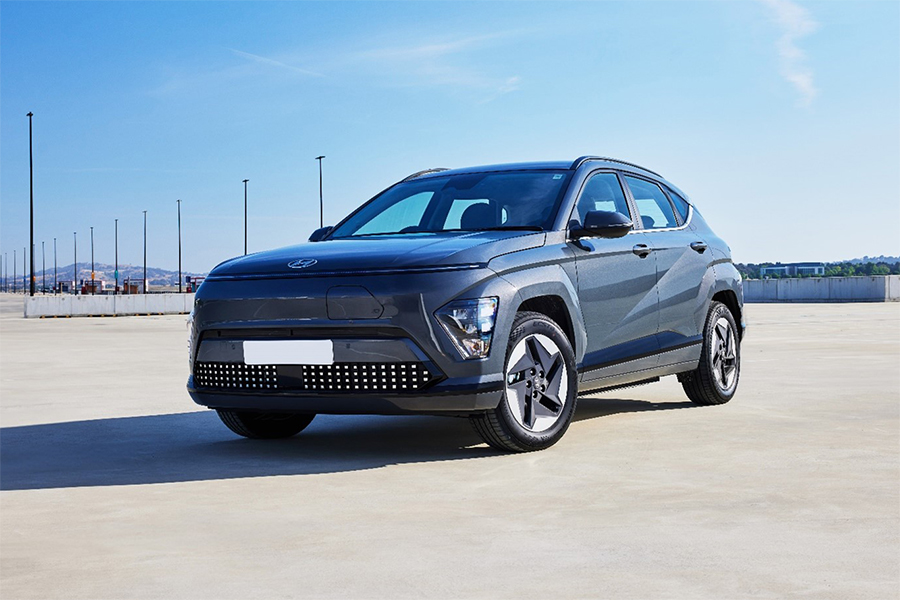
The South Korean brand claims the new-generation model was designed around the electric model, rather than it being an adaptation as it was with the original.
That means all Kona variants are physically larger than before and have a more spacious cabin that’s fitted with newer features.
Key elements on the EV include vehicle-to-load technology – accessed via a 250V three-pin domestic plug in the back of the centre console – that allows users to recharge or power other portable electronic devices such as power tools, laptops, e-scooters and even other EVs in remote locations. There’s also a much more modern dash with dual 12.3-inch digital displays, while Hyundai’s Bluelink telematics system with the over-the-air updates is also now included.
At the entry level, the Kona Electric is fitted with 17-inch aerodynamic alloy wheels, heated and power-folding exterior mirrors, an auto-dipping interior rear-view mirror, rain-sensing wipers, dual-zone climate control, smart key with push-button start, remote start and remote front window opening, three driver profiles to pre-set preferences and power lumbar adjustment for the driver’s seat.
As well as the bigger battery and more powerful motor, the Kona Electric Premium features larger 19-inch alloy wheels, a 12-inch head-up display, glass sunroof with power sunshade, a powered tailgate, leather upholstery, electric front seat adjustment (with heating and cooling), heating for the steering wheel and the rear seats, privacy glass and cloth-knit headlining.
A space-saver temporary spare wheel is standard across the range, and while towing might not be on your radar, models with the 150kW powertrain can now tow up to 750kg (braked).
What technology does the Hyundai Kona Electric feature?
The 2024 Hyundai Kona Electric has a 12.3-inch infotainment system with an embedded SIM offering Hyundai Bluelink connected services and over-the-air software update capability and voice recognition.
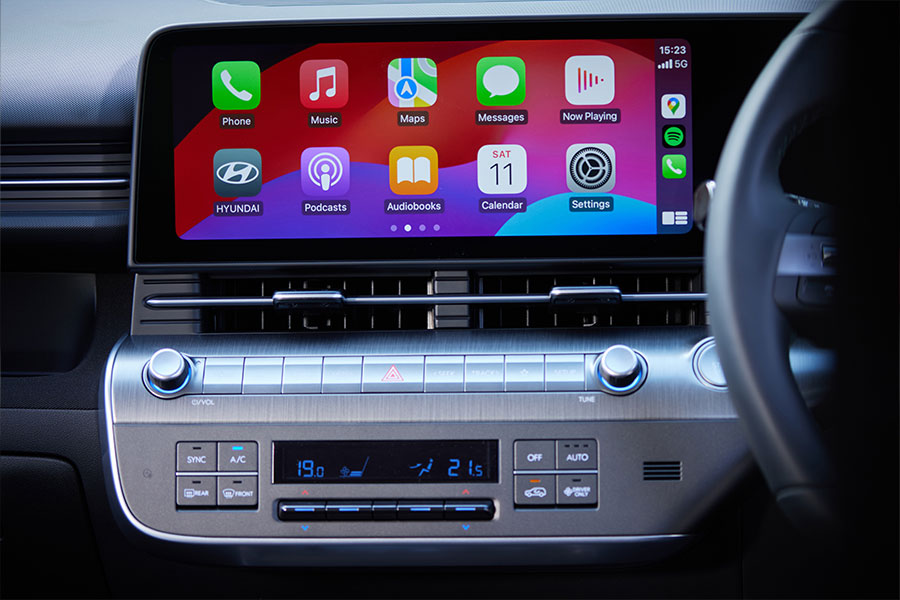
Wireless connections for Apple CarPlay and Android Auto are integrated into the system, along with embedded satellite navigation.
The instrument panel comprises a fully configurable 12.3-inch digital display.
A 15W wireless charging pad and two USB-C data/charging ports are found in the front compartment, plus another two USB-C outlets in the back.
Hyundai says the Type-C outlets are designed around the Power Delivery 3.0 standard, providing 27W/3A output for rapid charging.
What is the Hyundai Kona Electric like inside?
Because the 2024 Hyundai Kona range was designed around the electric model, there isn’t any variation from this to the more conventional versions.
Even though the sweeping digital dash and infotainment screen is impressive, as is the large centre console storage, the interior of the Kona Electric Standard Range feels a little dull and unimaginative. It seems as though the development budget didn’t stretch far enough to include higher-quality plastics.
There is a good deal of space inside and plenty of driver’s seat and steering wheel adjustment to get comfortable behind the wheel. Even at this base level, there is a very good lumbar adjustment to an otherwise quite supportive driver’s seat.
Rear seat space is also good, and while there is a lack of support across the bench, it would seem as though two adults would be able to travel on short journeys without getting uncomfortable.
The boot, which hides a space-saver spare wheel under the floor, offers 434 litres of cargo carrying capacity with all seats up. If you fold the 60/40-split rear seats down there’s 1268L available, plus 27L in the front boot.
How safe is the Hyundai Kona Electric?
The 2024 Hyundai Kona Electric has a generous suite of general safety and advanced driver assistance systems as standard, such as lane keeping/lane following assist, blind spot collision avoidance assist, and adaptive cruise control with stop-and-go.
Motorcycle detection in the forward collision warning suite is new for the 2024 Kona, while the rear collision warning system is supported by a rear-view camera and parking sensors. Front parking sensors are also provided, along with driver attention warning for leading vehicle departure.
Speed sign recognition (with audible warning if exceeded) is standard, too, and can be switched off if it becomes too distracting for the driver, although it reverts to ‘on’ each time the car is started.
The speed limit warning proved to be annoying at times, prompting us to turn it off, while the Kona EV’s driver distraction warning was also a source of frustration – it didn’t seem to like sunglasses or anything much else except the driver staring rigidly ahead.
The Premium grade adds a 360-degree surround-view monitor, remote smart parking, reverse parking collision avoidance system and full-width ‘seamless horizon’ projector-beam LED headlights. The base model still gets LED headlights and automatic high beam assist.
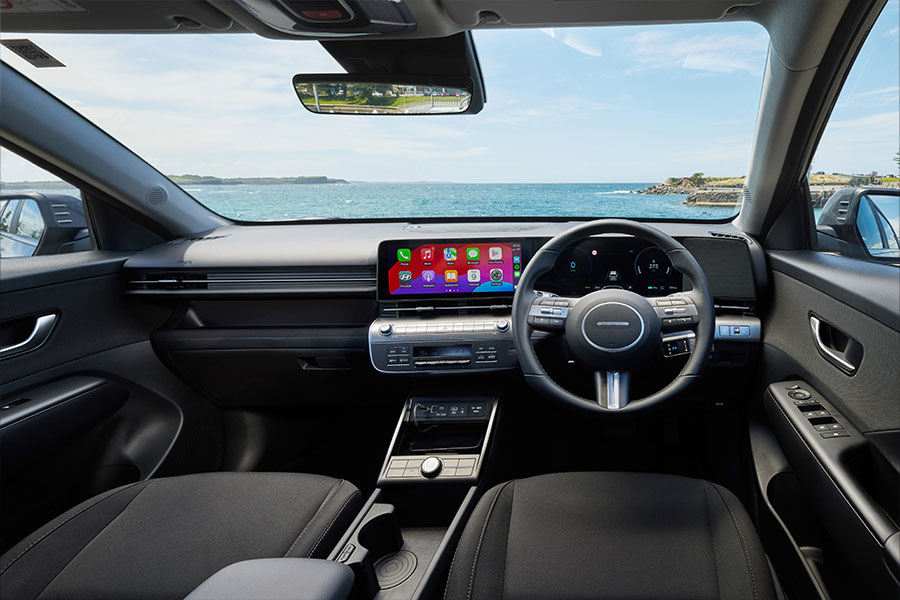
There are dual front, front side and curtain airbags across the range, plus the new addition of a centre front airbag that helps avoid head knocks between front occupants in the event of a crash.
Hyundai’s Bluelink connected services and smartphone app offer automatic collision notification and an SOS button for emergency assistance.
There are ISOFIX child restraint mounts in the two outboard rear seat positions and three top tether strap points. The rear seat is not sculptured, which means it is not so supportive for adults but provides a good basis for securing a baby seat or child seat booster.
The new Kona received a disappointing four-star (out of five) safety rating from ANCAP, based on the independent crash-test authority’s latest 2023 testing protocols. This was due to its performance for vulnerable road user protection and Safety Assist, scoring below the required 70 per cent threshold needed in both areas for a maximum five-star result.
In its report, ANCAP notes only ‘adequate’ performance of the Kona’s autonomous emergency braking (AEB) system in tests with pedestrians and cyclists, while the emergency lane keeping system was also assessed as only ‘adequate’, including in tests with a motorcycle.
What powers the Hyundai Kona Electric?
The 2024 Hyundai Kona Electric features a front-mounted permanent magnet synchronous electric motor that drives the front wheels via a single-speed reduction gear.
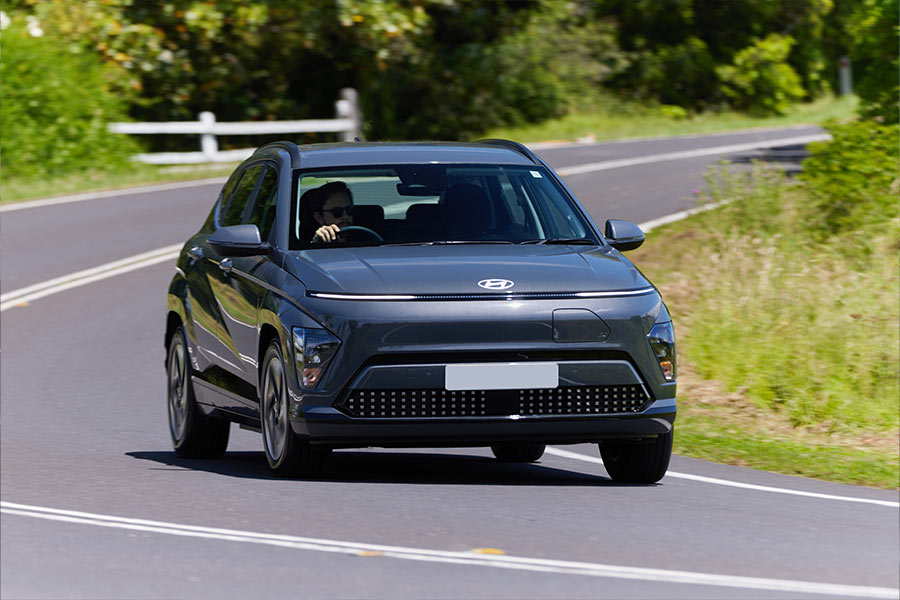
In the Standard Range model, it produces 99kW/255Nm (with a 48.6kWh lithium-ion battery), while the Extended Range has 150kW/255Nm (with a 64.8kWh battery).
For both models, that’s equivalent to the previous generation in terms of peak power (there’s just 1kW difference in the entry model), but it delivers significantly less torque (by 140Nm) torque than before. It was previously 395Nm for both versions.
According to Hyundai, the e-motor has been redesigned for the new Kona EV with a focus on smooth acceleration and efficiency.
New enhanced cooling channels help maintain the system at its optimum temperature, while the motor’s compact size allows storage space to be maximised.
The standard battery conditioning system can activate in cold climate conditions to heat the battery for improved DC charging and driving performance. This system can also pre-heat in preparation for fast charging, such as when a DC charger is set as a destination in the navigation.
A heat pump, instead of a conventional electric PTC heater, attends to cabin heating and utilises waste heat energy from other systems and energy from the atmosphere to warm the cabin in a reverse-cycle air-conditioning system.
Hyundai says that the Kona Electric features faster AC and DC charging than the previous model, with the addition of bidirectional charging capability.
The onboard AC charger now has a capacity of up to 10.4kW, compared with 7.2kW in the previous generation. As a result, DC charging time has improved; when connected to a 100kW DC fast-charging station, the new model can be recharged from 10 to 80 per cent in 45 minutes in both Standard and Extended Range form – or 65min when connected to a 50kW fast-charger.
How far can the Hyundai Kona Electric go on a charge?
The 2024 Hyundai Kona Electric Standard Range will average 14.8kWh/100km in the combined-cycle WLTP test for EVs, providing a range of up to 370km.
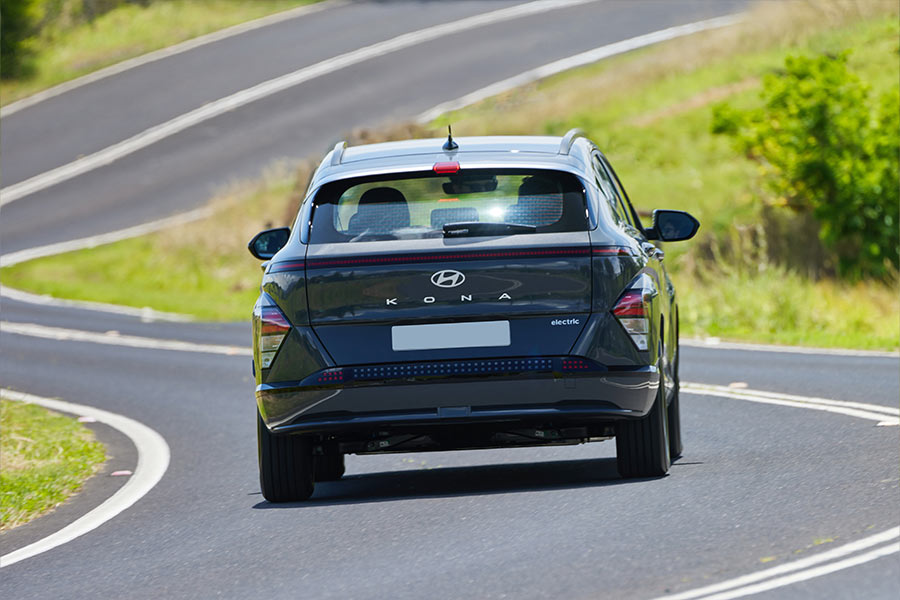
On the launch drive, we averaged 17.1kWh/100km in a combination of low-speed city and highway driving.
With its bigger battery pack, the Kona Electric Extended Range offers up to 505km on the WLTP cycle in the Standard Range model on 17-inch wheels, while the Premium, with 19-inch rims, has a claimed 444km of driving range.
In any case, the Kona is aided by aerodynamic enhancements, which creates a slipperier 0.27Cd drag coefficient compared to its predecessor (down from 0.29Cd).
What is the Hyundai Kona Electric like to drive?
The new 2024 Hyundai Kona Electric launch program took us on roads that Mitsubishi used for its iMiEV battery-electric car way back in 2011. What a contrast it is, this new EV versus one of the first to become available in Australia.
Yet it isn’t just that the Kona drive experience contrasts sharply with a now-very-old iMiEV battery-electric technology. It’s that it also puts some existing small SUVs of all stripes to shame in some areas.
The Kona Electric Standard Range absorbed the sometimes-terrible roads on our drive route with excellent control and subtlety, although tyre noise was a little too obvious at times.
The entry-level powertrain is really all you’ll ever need for around town, but it can take a while to wind up to match the traffic at highway speeds. When overtaking or otherwise needing an instant burst of speed, the Kona obliges with that typical instant EV pulling power, but it’s not as responsive as the previous model – a consequence of the reduced torque output.
For anyone upgrading from the previous model, that may actually be a welcome relief as its predecessor would easily spin the front tyres away from a standstill. Now, it feels more natural.
I didn’t get to play with the one-pedal (regen braking) settings enough, but it felt like this feature could be a bit stronger in the Kona Electric. I found myself brushing the brake pedal where in other EVs I wouldn’t.
Should I buy a Hyundai Kona Electric?
The 2024 Kona Electric makes the option to adopt battery power even easier.
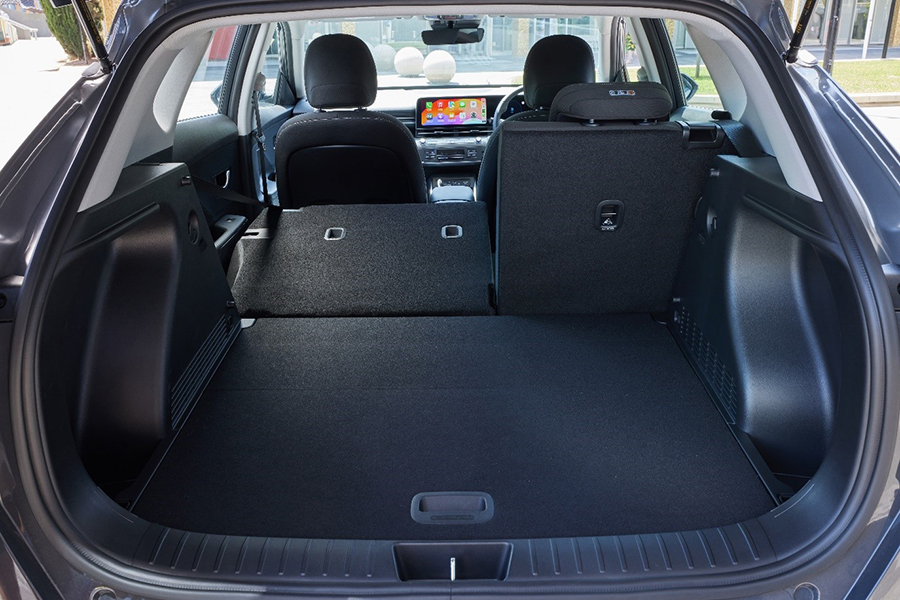
Because it was an integral part of the design process from the outset, it doesn’t feel compromised in any area: it’s spacious, comfortable, drives nicely and has decent driving range and charging capabilities. It’s also loaded with plenty of tech and the latest in high-tech safety systems, all of which – except the annoying driver monitoring and speed limit warning – work well.
If the interior was a little better finished, the performance a bit stronger and the driving range a little longer in this Standard Range model, then the new Kona Electric would seem to have all bases covered.
2024 Hyundai Kona Electric Standard Range at a glance:
Editor’s Rating: 8.1/10
| Price: $54,000 (plus on-road costs) |
Battery: 48.6kWh lithium-ion |
| Available: Now |
Range: 370km (WLTP) |
| Powertrain: Single permanent magnet synchronous motor |
Energy Consumption: 14.8kWh/100km (WLTP) |
| Output: 99kW/255Nm |
Safety Rating: Four-star (ANCAP 2023) |
| Transmission: Single-speed reduction gear |
Disclaimer: Images supplied by Hyundai Australia.
This article was prepared by an independent author. The information contained in this article represents the views and opinions of the original author, and is based on research carried out by the original author. The appearance of the article on Maxxia's website does not constitute an endorsement of its content by Maxxia in any way. The article has been made available for informational purposes only and should not be taken as advice. While all reasonable care has been taken to ensure that the statements made by the original author in the article are fair and accurate, Maxxia does not guarantee or warrant the accuracy or completeness of this information and will not be liable for, or in connection with, any loss or damage suffered as a result of any inaccuracies, errors or omissions or your reliance on this information. You should independently research and verify information before making any decision in respect of a vehicle.


